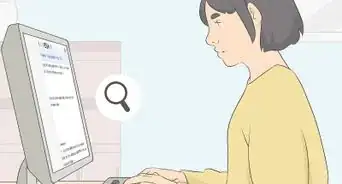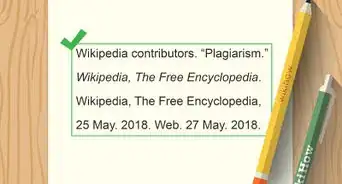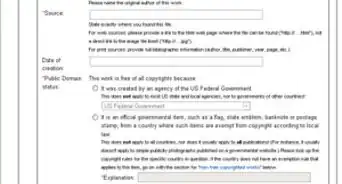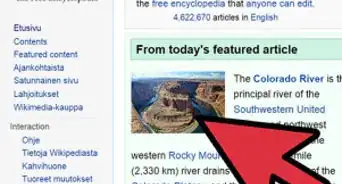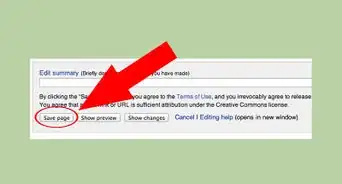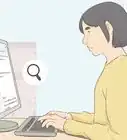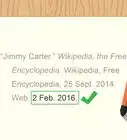wikiHow is a “wiki,” similar to Wikipedia, which means that many of our articles are co-written by multiple authors. To create this article, 9 people, some anonymous, worked to edit and improve it over time.
This article has been viewed 17,234 times.
Learn more...
As a Wikipedia administrator, you'll often find pages that may need to be deleted. If that's the case, read this article to find out how you can delete an article.
Steps
As an Administrator
-
1Become an administrator. Only administrators and bureaucrats are allowed to delete pages on Wikipedia.
-
2Go to the article that you want to delete.Advertisement
-
3Decide if it's necessary to delete the article. Not every article has to be deleted; some can be redirected to another article or merged into another article. Read the deletion policy for acceptable reasons for deleting articles.
-
4At the top of the article, under the "More" dropdown, click on the "Delete" button.
-
5Select the reason that you want to delete the page. There are a number of pre-selected reasons that you can use, although you're not required to use any of them; you can put in your own deletion reason in the "Other/additional reason" box.
- The most common reasons are the reasons that fall under one of the criterion for speedy deletion, proposed deletion, and sticky deletion.
-
6Click on "Delete page" to delete the article.
As a non-Administrator
-
1Find the article that violates the deletion policy, or that has no chance of improving.
-
2Decide how you want the article to be deleted. If the article meets one or more of the criteria for speedy deletion, then tag the article with
{{db-<csd code goes here>}}. If the article has no chance of improving, consider using the{{subst:PROD}}template, or using one of the XFD processes. If the article is a biography of a living person with no references whatsoever, then tag the article with{{subst:BLPPROD}}.- Criteria for speedy deletion discuss the only times where administrators can immediately delete a page.
- PROD templates (except for BLPPROD), once removed, cannot be reinstated. However, BLPPROD templates that are removed without any references may be reinstated, and PROD templates removed by blocked users may be reinstated.
- Deletion discussion is an avenue for articles that have been around for a while, do not meet the criteria for speedy deletion, and that appear to serve no purpose.
-
3Wait. The article may not be deleted if it no longer meets the deletion criteria. The creator and any substantial contributors of the page may not remove the speedy templates from the article, but may contest its deletion on the talk page.
List of the Criteria for Speedy Deletion[1]
The criteria for speedy deletion are the only cases where an administrator may immediately delete an article. All other deletions must reflect the result of a discussion.
| Short reason / code | Full reason | Example/scenario that meets criteria |
|---|---|---|
| G1 | Patent nonsense. | "aaaaaaaaaaaaaa" |
| G2 | Test page | "Does this work?" |
| G3 | Pure vandalism/blatant hoax | "Dihydrogen monoxide is a harmful compound in large quantities…" |
| G4 | Recreation of a page that there was consensus to delete | If a page was deleted, and the exact content of that page is recreated, regardless of title, then it falls under this criterion. |
| G5 | Creation by banned or blocked users | If a user is banned from creating pages in a specific topic or blocked from editing, they are not allowed to create pages that violate the ban or block. This does not apply to pages before the ban was imposed or after it was lifted. |
| G6 | Technical deletions | Maintenance, such as the deletion of redirects blocking page moves or pages created in error. |
| G7 | Author requests deletion | If an author requests deletion in good faith, for example a non-notable article, then the page may be deleted. |
| G8 | Pages dependent on a non-existent page | This includes talk pages of non-existent pages and broken redirects. |
| G9 | Office actions | Any deletion carried out to enforce a decision made by the office. These may not be reversed without consulting the Wikimedia Foundation. |
| G10 | Attack page | "This guy is a sore loser…" "Sue this guy. He is terrible." |
| G11 | Unambiguous spam | "Call this toll free number to lose weight!" |
| G12 | Unambiguous copyright violations | "It was the best of times, it was the worst of times…" (if A Tale of Two Cities was still copyrighted) |
| G13 | Abandoned Drafts | Article drafts unedited in six months. |
| G14 | Unnecessary disambiguation | "X may refer to [only one page]" / "X refers to this (with no link to pages)" |
| Short reason / code | Full reason | Example/scenario that meets criteria |
|---|---|---|
| A1 | No context | "He won an award for doing X." |
| A2 | Foreign language articles existing on another Wikimedia project | "Romeo es una persona que…" |
| A3 | No content | " " |
| A5 | Transwikied articles | Articles copied to another Wikimedia project per consensus |
| A7 | No indication of importance (people, animals, organizations, events) | "John is an actor." (Explain what makes John important enough to deserve a Wikipedia article. Maybe he won an award?) |
| A9 | No indication of importance (music) | "X is a song by Jill." (Explain what makes this song important enough to deserve a Wikipedia article. Maybe this ranked near the top of the Billboard Hot 100?) |
| A10 | Duplicate | If a new article duplicates another article, and the title is not a plausible redirect, then the article may be deleted. |
| A11 | Obviously invented | "Abladoo is a product that makes your car fly." |
| Short reason / code | Full reason | Example/scenario that meets criteria |
|---|---|---|
| R2 | Cross-namespace redirects (except main to Category:, Template:, Project:, Help:, and Portal:) | Best user ever → User:Best user ever Hi → Draft:Hello |
| R3 | Implausible Typos | Goooooooooogle → Google 3.14159265358979…1 → Pi |
| R4 | File namespace redirects with Wikimedia Commons matches | This applies to files where the name overlaps a file or redirect on the Wikimedia Commons. |
| Short reason / code | Full reason | Example/scenario that meets criteria |
|---|---|---|
| F1 | Redundant | A duplicate of an identical file with the same format. |
| F2 | Corrupt/empty | |
| F3 | Improper license | ND (no derivatives), NC (non-commercial), GFDL 1.3 and earlier |
| F4 | No license or source | Files with a missing license or source may be deleted after seven days. |
| F5 | Orphaned non-free images | Copyrighted images that are not used in articles within seven days may be deleted. |
| F6 | Missing non-free rationale | Images that do not have a fair use rationale may be deleted after seven days. |
| F7 | Invalid fair-use claim | Invalid non-free tag, images from a commercial source, images replaceable by a free image, disputed fair use claims |
| F8 | Identical copies of Commons files | Duplicate files that are unprotected and have no specific meaning to Wikipedia |
| F9 | Unambiguous copyright infringement | Reuploads of copyrighted files |
| F10 | Useless non-media files | Files that are not sound, video, or images and that are not useful for use in articles. An example would be a homework assignment. |
| F11 | No evidence of permission | If there is no evidence of permission to use an image by the copyright holder, then it may be deleted. |
| Short reason / code | Full reason | Example/scenario that meets criteria |
|---|---|---|
| C1 | Empty categories | Categories that consist of no subcategories, articles, or files. |
| Short reason / code | Full reason | Example/scenario that meets criteria |
|---|---|---|
| U1 | User request | User pages that the user requests deletion of. Does not apply to talk pages. |
| U2 | Non-existent user | If the user does not exist in the database, and they were not renamed, then those user pages can be deleted. |
| U3 | Non-free galleries | User pages that consist solely of non-free images. |
| U5 | Misuse as webhost | User pages consisting of content unrelated to Wikipedia's goals |
| Short reason / code | Full reason | Example/scenario that meets criteria |
|---|---|---|
| P1 | Any portal that could be deleted as an article | Portals that meet the article criteria for speedy deletion |
| P2 | Underpopulated portal | Any portal with fewer than three non-stub articles or where there is only a stub header article. |
How Proposed Deletion Works[2]
Proposed deletion (PROD) is an alternative to discussion that allows for deletion of an article if an editor identifies major problems with the article. Articles that are PRODed may be deleted after seven days. If the tag is removed, or if the article closed as "keep" at an XfD venue, then the tag may not be readded. (Exceptions include other edits that do not signify an objection to deletion (such as page blanking/vandalism) or edits that evade bans/blocks.) To tag an article for proposed deletion, type {{subst:PROD|reason=reason here}} at the top of a Wikipedia article.
Exceptions are proposed deletions of biographies of living people (BLPPROD).[3]
If an article is about a living person and there are no sources in the article, then it may be tagged with {{subst:BLPPROD|reason=reason here}}. Unlike regular PRODs, BLPPROD tags can only be removed if and only if a supportive reliable source is added to the article. If the tag is removed but no reliable source is added, then the tag may be reinstated.
PRODed and BLPPRODed articles may still be undeleted after a successful request for undeletion.
Warnings
- Use the deletion tool with good judgment. Consistently making bad deletions can result in your administrator rights being taken away.⧼thumbs_response⧽
